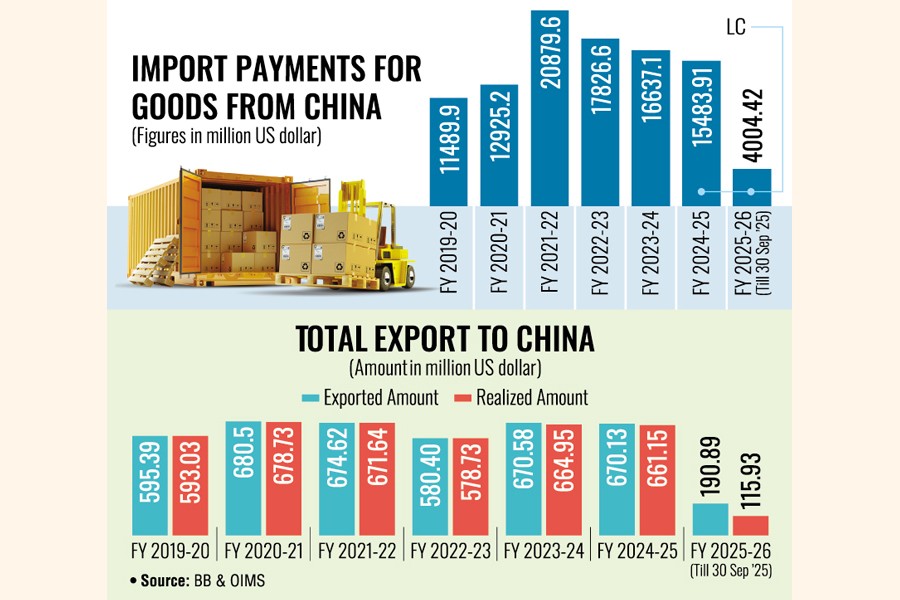Bangladesh's exports to China remain stagnant amid duty-free access

Published :
Updated :

Bangladesh's trade imbalance with China continues to escalate, driven by persistent higher imports of essentials for its industries from the country's top import destination.
On the other hand, Bangladesh's exports to China remained almost stagnant in recent years despite having duty-free market access there.
China now supplies about 22 per cent of Bangladesh's total imported goods, especially industrial raw materials, intermediate goods and machinery.
Such a large volume of imports reflects an increased dependence of Bangladesh's industries on Chinese raw materials and capital machinery, according to traders and experts.
The central bank's latest data from the fiscal year 2019-20 until September of the FY 2025-26 showed that Bangladesh's imported goods from China ranged between $11 and $20 billion annually against its exports amounting to $500 to $600 million.
Bangladesh's imported goods from China, which stood at $11.49 billion in FY20, climbed sharply to a record $20.88 billion in FY22, amid strong industrial expansion and development of large-scale infrastructures.
However, the growth trend showed downward in recent years, with imports falling to $17.83 billion and $16.64 billion in FY23 and FY24 respectively as Bangladesh economy came under pressure from tightening foreign exchange reserves and moderated manufacturing activities.
The downtrend continued in FY25 with the value of import LCs totaled at $15.48 billion, while the country's imports from China during the first quarter of FY26 recorded at $4.04 billion, indicating a cautious import behaviour and slower industrial demand.
In contrast, Bangladesh's exports to China remained largely stagnant over the past six years, hovering between as high as $580 million and about $680 million annually.
Over the seven-year period, Bangladesh's total exports reached $4.06 billion, with the realised receipts amounting to $3.96 billion.
According to year-wise data, the country's exports to China were $595.39 million in FY20, $680.50million in FY21, $674.62 million in FY22, $ 580.40 million in FY23, $670.58 million in FY24, $670.13 million in FY25, and $190.89 million in the first quarter of FY26.
Although China has granted duty-free access to 98 per cent of Bangladeshi products, the latter's export growth remained almost static primarily due to the factors like ongoing competitive market, and absence of diversified products and readiness to meet the demands of the Chinese market. According to experts, the growing trade imbalance indicates deeper structural issues in Bangladesh's industrial dependency on China.
Dr Masrur Reaz, Chairman of Policy Exchange Bangladesh, said the persistent imbalance reflects the structural dependence of Bangladesh's manufacturing sector on Chinese inputs."
"More than 30 to 35 per cent of our industrial raw materials and machineries come from China. This import dependency is unavoidable for now, but it puts pressure on our current account and creates supply chain concentration risks" he said.
"Bangladesh needs to diversify its sourcing and invest in local backward-linkage industries to reduce this vulnerability," he added.
The economist also noted that the sharp rise in imports from China, which crossed $20.88 billion in FY 22, was driven by large-scale post-pandemic industrial expansion, much of which relied heavily on Chinese capital machinery and intermediate goods.
Exporters, however, said Bangladesh's reliance on China remains unavoidable, driven by both competitive prices and the steady availability of essential raw materials.
Mahmud Hasan Khan, President of the Bangladesh Garment Manufacturers and Exporters Association (BGMEA), said Bangladesh relies on China not just because of lower and competitive prices, but also due to the assured availability of raw materials.
"At this moment, importing from China is not merely a choice-it's a necessity to keep our operations running smoothly," he noted.
The BGMEA leader said Bangladesh has room to expand its non-traditional and basic apparel lines, such as T-shirts, especially as China is scaling back its cotton imports from the United States.
"Many of today's non-traditional RMG items will become mainstream within the next decade," Khan added.
He also stressed the need for broader export diversification to lessen the country's trade gap with China.
"We should focus on expanding our export basket, including agricultural products like mangoes," he said.
sajibur@gmail.com


 For all latest news, follow The Financial Express Google News channel.
For all latest news, follow The Financial Express Google News channel.